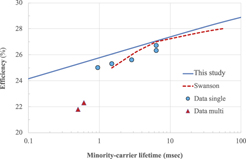Article contents
Analysis for efficiency potential of crystalline Si solar cells
Published online by Cambridge University Press: 14 September 2018
Abstract

Efficiency potential of crystalline Si solar cells is analyzed by considering external radiative efficiency (ERE), voltage, and fill factor losses. Crystalline Si solar cells have an efficiency potential of more than 28.5% by realizing ERE of 20% from about 5% and normalized resistance of less than 0.05 from around 0.1. Nonradiative recombination losses in single-crystalline and multicrystalline Si solar cells are also discussed. Especially, nonrecombination and resistance losses in multicrystalline Si solar cells are shown to be higher than those of single-crystalline cells. Importance of further improvement of minority-carrier lifetime in crystalline Si solar cells is suggested for further improvement of crystalline Si solar cells. High efficiency of more than 28.5% will be realized by realizing high minority-carrier lifetime of more than 30 ms. Key issues for those ends are reduction in carbon concentration of less than 1 × 1014 cm−3, oxygen precipitated and dislocations even in single-crystalline Si solar cells, and reduction in dislocation density of less than 3 × 103 cm−2 in multicrystalline Si solar cells.
- Type
- Invited Paper
- Information
- Copyright
- Copyright © Materials Research Society 2018
References
REFERENCES
- 11
- Cited by




